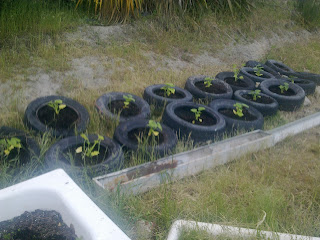I found this magazine in the supermarket one day. I bought one copy and while there were a
couple of articles that interested me in it, I was rather underwhelmed. I left it for about six months and the cover
of the latest issue caught my eye.
Since then, I've fallen in love with this magazine. It’s become my must-have purchase once a
month. I read through the articles that
I really want to read first and then go through another time reading all the
bits that I skipped. Then I usually go
through a third time to see if I’ve missed anything. Then I wait for 3 weeks for the next one!!
The articles are sensible, practical and cover both commercial
farming applications and the small mostly clueless townie trying to live the
country life (like us). For the most
part they walk this centre line without being condescending to the clueless or
so filled with unexplained jargon that only the big commercial farmer would
understand it. I say ‘unexplained
jargon’ because when the jargon is used, the meaning is usually also explained
- very handy for those of us who are learning the whole new language that is
livestock, pasture and rural life.
There are feature articles and regular columns and I’ve come to
love both. The tips and tricks that I’ve
learned for many things have been extremely handy. I’ve picked up things to do some more
research on (pelton wheels generating electricity from the water in your drains!!) and read
stories of people who’ve managed to turn their little slice of land into a
success story. There are also the things
that haven’t worked for some people, the mistakes they’ve made that they’re
sharing with others so they don’t fall into the same traps. I learned the laws around homekill and the
truth about the much propaganda-ised food bill.
I love Murray Grimwood’s column “The Good Life”, this guy is not
afraid to say he cocked something up and explain how he’s thinking of fixing
it. He’s smart, passionate, resourceful
and a delight to read. He also has a
blog here.
What has really impressed me is that for the third time, there
will be something that I’m considering and researching. I spent several hours going through my
collection looking for the little snippets that have hinted toward this thing
I’m thinking about. When I’m just about
there, the next issue will have an article that features my latest “thing” and
makes it all clear.
This month's one was about planting herbs that are beneficial to
your livestock. There is a new column
(well it’s been going for probably about 4 months) about building your block
from scratch and making the effort to get things right in the design. It’s written by a block/landscape
designer. It mentioned herbal leys and
there were a couple of herbs listed that are good to have growing in a junction
planter (those triangle fenced off bits you see here and there in paddocks) and
their benefits for your stock. I’d also
heard a few bits from others who have done this sort of thing before. I listen to everyone and then sift the useful
from the not-so-much. Imagine my delight
when the feature on the cover was “How herbs can improve your block” and
covered not just herbs for big livestock but also herbs for poultry! That covered something I’d been thinking
about in a totally different area.
I’m sure the editor or the writers have some gift for knowing
what I need to be reading right now. Or
maybe, it’s a seasonal thing - something that most of us are thinking about at
these times. Either way, I thank them
for it and long may it last!










